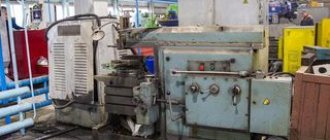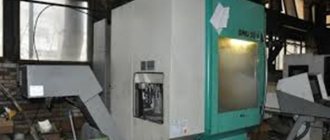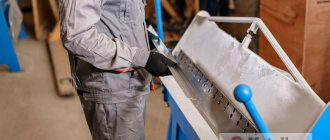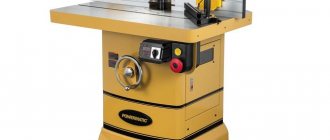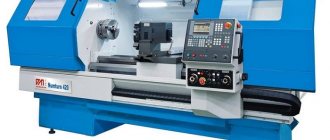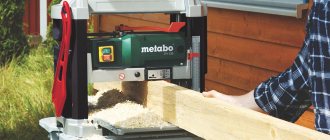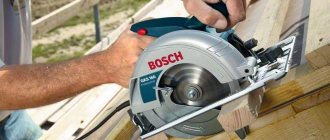Metal planing machines are designed for roughing and finishing processing of workpieces of various shapes. Thanks to the ability to replace cutters, you can achieve the desired processing speed, cut various metals, and obtain the required level of productivity. Used in industry, workshops, repair shops.
Cross-planing machine (Photo: Instagram / kubanzheldormash)
Specifications
Technical characteristics of planing machines:
- working surface size - from 200x180 mm to 1500x6000 mm;
- maximum height of the processed workpiece - up to 1.23 m;
- the maximum distance between the working surface and the crossbar is 1.25 m;
- permissible weight of parts - up to 8 tons;
- electric motor power, depending on the machine model - from 500 W to 150 kW;
- the maximum angle of rotation of the incisors in both directions is 600;
- processing speed - from 3 to 60 m/min.
Design and principle of operation
The mechanical part of planing machines consists of the following elements:
- cast iron or steel frame - the main part of the structure that bears the main loads, used to accommodate the assembly with the cutting tool and the work table;
- working surface - designed for placing workpieces and fastening them;
- guides—necessary for moving the slider or working surface;
- slider - performs translational movements when processing workpieces;
- a cutter used for cutting metal;
- caliper - fixes the cutter at a certain angle;
- gearbox - used to change the rotation speed of the spindle with a fixed workpiece;
- vice for fixing parts during processing.
The design also includes electrical components: motor, controls, monitoring sensors, protection systems. To cool the mechanical elements, a system for supplying lubricants and coolants is used. All machine components are located inside a steel or cast iron body.
The operating principle is based on direct contact of the cutting tool with the workpiece. Machining occurs when the workpiece moves or rotates relative to the cutter.
Processing the part (Photo: Instagram / khuevgen)
Electrical equipment, light, lighting
0 votes
+
Vote for!
—
Vote against!
Many people prefer to do small carpentry work at home or in the countryside. This allows you to give free rein to your imagination and save money from the family budget. But to work with wood, you need available tools, for example, a planer, which you can make yourself.
The emergence of the planer
The first planing machine has been known since the time of Leonardo Da Vinci. But it did not influence the development of this equipment, since all records were lost. The scientist de la Hire from France in 1719 designed a planing machine, which was originally a modification of a lathe, and the movement was carried out by a rope from the beam.
And today there are many different planing machines, which, depending on the work performed, are divided into the following groups: general purpose machines, specialized and special machines.
General purpose machines include longitudinal planing and cross planing. Special machines are designed to perform specific detailed operations and are mainly used in mass production.
Specialized machines include cross-planing machines with a movable carriage for working with heavy parts, pit longitudinal planing machines for processing heavy and large parts, and edge-planing equipment for processing the edges of large sheets.
The longitudinal planing machine is designed for processing large workpieces. Such devices come in single- and double-column types. In the process of cutting metal on a longitudinal planing machine, movements are transferred to the workpiece, which is previously fixed on the table of the planing machine. Its main characteristics are the width and length of the planing. The maximum length reaches up to 25, and the width reaches 5 meters.
A cross-planing machine is used to work with medium or small workpieces. The movements are transmitted to the cutting tool, and not to the workpiece. This tool is placed on a slide. A characteristic of such a planing machine is the stroke length of the slide, which reaches 2.5 meters. You can move the table where the workpiece is fixed in horizontal and vertical planes.
Purpose of planing machines
Planing machines are necessary for processing ruled surfaces - vertical, horizontal and inclined planes. Ruled surfaces also include shaped surfaces, which are a combination of planes located at different angles.
With the help of metalworking and woodworking planing machines, it is also possible to process shaped surfaces, the profile of which has curved sections that are formed by circular arcs or complex curves. Planing machines process not only flat surfaces, but also grooves, straight grooves, ledges and various recesses. It is possible to process metal in a closed loop.
Small-sized parts and large forgings, welded structures and castings that have a length of up to 12 meters, a width of up to 6 meters and a height of up to 3 meters are processed using a planing machine. The weight of such parts can reach up to 200 tons.
On planing machines, the workpiece is processed along a plane, thickness or angle, thanks to which the lumber acquires ideal evenness. On a double-sided jointing machine, the layer and the edge of the part are simultaneously processed. Parallel planes are processed using double-sided thicknessing equipment.
Metal-cutting machines of a planing nature are used in special machine shops for processing all kinds of parts in the automotive industry. They are also found in many repair shops and tool shops. They are well suited for working with parts made of steel, various non-ferrous alloys and even some types of plastic.
Wood planing machines are used to process the surface of wood after sawing “clean”, making lumber and parquet. They are designed for processing straight workpieces and plane milling. Using different sets of knives allows you to work with soft (spruce, pine) and hard (poplar, oak, beech) wood species.
Planing machine design
A planing machine consists of such basic elements as a cutter shaft, a motor, a work table and rollers. The work table is divided into two parts; a knife shaft passes between them, which serves to cut the upper part of the workpiece. Workpieces are fed automatically or manually. As the workpiece moves around the machine, it is supported by special rollers.
A special feature of the planing machine is a mechanism that helps regulate the thickness of the planing and ensures installation with an accuracy of tenths of a millimeter. The basis of the planing machine is a frame welded from steel corners that have a cross-section of 50 by 50 millimeters. The width of the frame depends on the distance between the shaft support bearings. The housing is secured to the frame using bolts. The transverse fastenings are reinforcement bars.
The desktop is made of two halves - fixed and movable, which are mounted on a frame made from a corner, which has a cross-section of 25 by 25 millimeters. The width of both frames is equal to the width of the frame, and the length is 50 millimeters less than the length of the tables. The countertops are made from metal sheets 3 millimeters thick.
The frame of the fixed table is attached to the frame by welding using racks, which has a cross-section of 10 by 40 millimeters. A fixed table with stands that are welded to the frame is mounted like this. First, it is aligned relative to the planing shaft with the help of auxiliary wedges and bars - strictly parallel to the bed. This position is fixed by welding the racks to the frame.
The movable type table is a structure of triangular cross-section: in the planer diagram, the sidewall and frame with the table top are the legs, and the base plate is the hypotenuse of a right-angled isosceles triangle. You can change the height of the table relative to the shaft by moving the base plate along the guides using a screw mechanism according to the type of lanyard.
The tabletop sheet is attached to the frame using countersunk screws. This helps to adjust the initial position of the tabletop relative to the stationary table and shaft by installing spacers. The cotter pin, which is attached to a fixed corner, limits the movement of the mobile table by more than 3 millimeters in height.
When planing different workpieces, a guide ruler is provided as a stop. Its design allows you to change the angle of the supporting surface relative to the table within certain limits. Homemade planing machines use an electric motor with a power of 1.5 kW and a rotation speed of 2850 rpm.
Working principle of planing machine
The workpiece on the longitudinal planing machine is fixed on the table, which makes a reciprocating movement. The cutters are fixed in supports. The cutter together with the support relative to the workpiece moves after a double stroke of the table by the feed amount in the transverse direction, thereby ensuring the cutting of the metal layer, and after that the cycle is repeated.
The design of the longitudinal planing machine has a mechanism that ensures reciprocating movements of the table together with the workpiece and feed of the cutter in the horizontal or vertical direction. The machines have automatic feed of the table and cutting support. They can be controlled using a central push-button station and conveniently located handles. This is something to consider before making a planer.
The reciprocating movements of the cutter are the main movements, and the periodic vertical or transverse movement of the table with the workpiece is the feed movement.
Typically, the table is driven by a DC electric motor through a gearbox, which, together with stepless speed control, ensures smooth cutting into the workpiece of the cutter and, at the end of the working stroke, its slow exit. Based on general planing machines, specialized machines and devices are manufactured in which the planing procedure is combined with boring, milling and grinding. Remote control of the functioning of the machines is carried out from a pendant push-button station.
Making a planer
The manufacture of any equipment for metal processing, including a do-it-yourself planing machine, begins with the preparation of a corresponding drawing. Decide on the size of the machine and the functions it will perform. Choose sizes based on your own requirements.
It is not advisable to make a large machine for home needs. Think about where it will be located. The planer is a bulky and heavy structure, so at the very beginning you need to choose the place where you will screw the legs to the floor. This is required so that the planer does not move from vibrations during use.
The drawing should reflect all design features and the exact dimensions of each element. It is recommended to make the drawing in two versions - finishing and rough. Carefully check the correctness of the planing machine drawing to avoid errors and damage to the material.
It is best to make the main frame of the machine from steel beams. Weld them together. Weld crosshairs between parallel beams. This can give the structure additional rigidity and strength. Also remember about additional stiffeners for attaching the saw and motor. Apply a thin layer of primer to the cooled and plastered beams. Wait until the surface dries and paint the structure with any waterproof paint.
Lay several thick boards on top, which should be fastened with bolts and nuts. Apply lubricant to the bolts before tightening. It is necessary to make a neat cut between the boards in the place where the saw blade will be located. The surface of the boards should be thoroughly sanded. Remember that there should not be large gaps between the boards. If desired, additionally make a device for screwing a steel vice.
After this, you need to install the saw blade drive and carefully tighten the fastening bolts. Check that the blade guides are located in the middle of the cut. Check the functionality of the mechanism that guides the boards under the disc. Install a diesel or electric motor into the frame, which must be connected to the drive.
If the motor is electric, it is recommended to carefully disguise the electrical wire. When using a diesel engine, you need to take care of a special pipe through which the exhaust gases escape. Now the machine is ready! You can turn on the assembled machine and check its functionality.
Now you know that with the help of a planing machine you can process metal and wood, or rather, planing products. But the price of planing machines is too high, and the average owner is unlikely to afford to buy such equipment. If you really want, you can make such a machine yourself if you carefully follow our recommendations and adhere to the instructions.
Types of metal planing machines
Classification of metal planing machines according to processing technology:
- For longitudinal planing. The table with the part moves relative to the cutter.
- For cross planing. The cutting part moves above the work table on which the part is fixed.
By type of drive:
- hydraulic - moving mechanisms move or rotate at a constant speed;
- crank-crank - the units move in accordance with the settings of the rocker mechanism, that is, the speed can be selected for a specific processing technology.
According to the method of influencing the workpiece:
- lingering - used to remove surface layers (horizontal, vertical or a combination of the first two options)
- shaped-planing - designed to create complex curved surfaces;
- slotting - used to create holes and grooves when moving the cutting tool exclusively along the vertical axis.
Nomenclature and designation
All standard sizes of planing equipment are included in the group of machines for processing flat surfaces. At the same time, general-purpose machines (both transverse and longitudinal planing), specialized and special ones are separately marked.
The general classification index for such equipment includes an alphanumeric designation of the type XXXX. The first index - a number - determines the classification of the machine to a certain type. For the equipment in question, this is always the number 7. This is followed by a number that indicates the type of machine:
- 1 – single-column longitudinal planer;
- 2 - two-post longitudinal planer;
- 3 – cross-planing;
Schemes of metal processing by planing
The last two digits of the marking indicate the main technological parameter of the equipment. As a rule, this is the largest dimension of the processed product in decimeters. For example, brand 7310 will indicate that this unit is a cross-planing unit and is intended for processing metal with a maximum plane length of up to 1000 mm. The letter in the designation (for example, 7A110) indicates a modification of the base model (for example, the presence of a hydraulic drive, an additional clamping unit, etc.). The presence of the letter F in the designation indicates that this equipment is equipped with a CNC system.
How to choose a planing machine
Criterias of choice:
- desktop area;
- installed engine power;
- speed of movement of the cutter relative to the workpiece;
- available cutting methods;
- table configuration;
- possibility of positioning the cutter: angle of inclination, trajectory of movement;
- degree of protection of the housing from dust and moisture;
- maximum permissible weight of processed parts;
- manufacturer, warranty period, availability of additional options to expand functionality.
Equipment configuration (Photo: Instagram / kubanzheldormash)
Advantages and disadvantages
Advantages of planing machines:
- versatility of application - processing of various types of metals;
- selection of optimal cutting speed;
- wide selection of cutting tools;
- the possibility of roughing or finishing to obtain the desired level of surface roughness;
- high strength of the body, capable of withstanding increased loads from the cutting tool and the weight of the part;
- convenient control;
- formation of surfaces of complex shape;
- high reliability of installed components and assemblies.
Flaws:
- loss of time moving the cutter relative to the workpiece;
- inertia of moving mechanisms;
- high level of vibrations;
- engine noise;
- the difficulty of obtaining high engine speeds under load or at idle in a short period of time.
Cost and manufacturers
In Russia, machines are produced at the following enterprises:
- Sverdlovsk Machine-Building Plant LLC (SMZ);
- Ryazan Machine Tool Plant LLC (RSZ);
- OJSC "Orenburg Machine Tool Plant" (OSZ);
- OJSC "Astrakhan Machine Tool Plant" (ASZ);
- Lipetsk Machine Tool Company LLC;
- Verkhnevolozhsk Machine Tool Plant.
Cost of machines, depending on their types:
- slotting - from 100 thousand rubles;
- compact - from 35 thousand rubles;
- combined - from 600 thousand rubles;
- transverse - from 65 thousand rubles;
- industrial longitudinal planing machines - from 7 million rubles.
Slotting and planing machine (Photo: Instagram / krasnyi_mehanik_)
Overview of the machine range
The main developer and manufacturer of planing equipment of this group is the Orenburg SZ; many domestic companies offer to purchase ready-made, repaired or modernized devices, Pressmash, Stanochny Mir); among used machines, the products of the Gomel SZ have good reviews. The models have a generally similar design, the differences are manifested in the dimensions, power and parameters of the workpiece being processed. The main indicators of the most common of them are presented below:
7305T
| Characteristic | 7305T | 7307GT |
| Slider stroke, mm: | ||
| largest for planing | 500 | 710 |
| largest for chiselling | 200 | 250 |
| Dimensions of the upper working surface of the table, mm | 500x400 | 710x450 |
| Slider stroke frequency, stroke/min | 13,2-150 | 10,6-118 |
| Table feed, mm/double stroke: | ||
| Horizontal | 0,2-5,0 | |
| Vertical | 0,04-1,0 | |
| Main drive power, kW | 5,5 | |
| Weight 7305T machine (without accessories) kg, max | 1980 | 2770 |
| Overall dimensions of the machine, mm | 2380x1085x1560 | 2790x1375x1665 |
| Overall dimensions of packaging, mm | 2400x1306x1620 | 2800x1400x1740 |
This equipment is distinguished by its increased rigidity of the frame and guide and has a good power resource (up to 5500 W), facilitating the precise performance of finishing, roughing and fine planing.
The machine is equipped with a 500×400 rotary table with 25 feeds and three T-shaped slots for gripping workpieces with a slide stroke of up to 510 mm and an outreach of up to 560; the maximum distance between the horizontal plane and the guides is 40 cm.
7307TD
Expanded modification 7305T with a slotting head and a slider stroke increased to 710. By analogy with the previous one, this cross-planing machine is recommended to be purchased when processing flat and shaped workpieces made of hard materials (the permissible cutting force reaches 19.6 kN); with equal power and table movement speed, it wins in functionality and increased working space.
This affects the price; in new condition, this model can be purchased from 800,000 rubles and above. At the same time, its optimal scope of application is enterprises with single and small-scale production conditions.
7B35
Planing equipment for processing with a cutter workpieces with a length of up to 500 mm inclusive and forming grooves and grooves in them with different shapes and depths within the cross-section of the working tool 20×32 mm. The model was developed for installation in repair, mechanical and tool shops of mechanical and instrument manufacturing enterprises with relatively small production volumes (single and small-scale production of metal parts).
In the basic version, 7B35 has a fixed table with 20 feeds and manual, mechanical and root movement; models with universal rotary structures are made to order. The machine is equipped with a centralized lubrication unit and a chip collector; the estimated costs for purchasing it in basic configuration and in good condition are 600,000 rubles.
7M36 and 7M37
The machine has 2 electric motors (the main one ensures the start of all components, the auxiliary one ensures rapid movement of the worktable with dimensions of 450×700 and 560×1000 mm, respectively), the lubrication of its frame and slider guides is carried out automatically, the same applies to the feed of the support and cutter.
OD61-5
Combined planing equipment with a slotting head, used for processing flat, shaped and inclined surfaces and cutting grooves and grooves in workpieces with a length of no more than 500 mm. OD61-5 meets all the requirements set for the 7305TD and 7307TD machines; while inferior in the size of the produced part, it gains in functionality due to being equipped with three-position rotary and round tables.
| Characteristic | OD61-5 | OD61-7 |
| Slider stroke, mm: | ||
| largest for planing | 500 | 710 |
| largest for chiselling | 200 | 200 |
| Dimensions of the working surface of the table, mm | ||
| rotary table in horizontal position | 500x400 | 710x450 |
| tilt table | 360x360 | 360x360 |
| Diameter of the working surface of the round table, mm | 360 | |
| Slider stroke frequency, stroke/min | 13,2-150 | 10,6-118 |
| Table feed, mm/double stroke: | ||
| Horizontal | 0,2-5,0 | |
| Vertical | 0,04-1,0 | |
| Main drive power, kW | 5,5 | |
| Weight 7305T machine (without accessories) kg, max | 2200 | 3000 |
| Overall dimensions of the machine, mm | 2410x1300x1560 | 2820x1575x1665 |
| Overall dimensions of packaging, mm | 2306x1238x1710 | 2426x1268x1825 |
In addition to conventional planing operations, it is used to process surfaces with a given slope, form spline holes, keyways and other slotting work.
DIY making
Step-by-step creation of a planing machine:
- A drawing, detailing, and cost estimate are created.
- All necessary materials are purchased.
- A supporting frame is made of steel beams, the walls are sheathed with steel sheets.
- The work surface is attached.
- Guides are installed.
- The frame and slider are attached.
- A vice and support are mounted.
- The electric motor is installed, the wiring is laid.
- The motor shaft is connected by a belt drive to the flywheel on which the workpiece is mounted.
- If necessary, a tube with coolant is supplied, as well as a bath to drain its excess into the sewer.
- The correct assembly is checked and tested at design loads.
- Equipment adjustment.
Thicknesser for thin boards with base
A machine with the same technological characteristics as the previous category. On the other hand, big differences are observed in the size of the product, in fact we are faced with the impressive body of the machine and the possibility of installation on the ground.
Productivity increases significantly due to higher motor power and often the ability to handle larger pieces of material. This increased power can also mean greater planing depth.
Equipment operation
When using machines, you must follow a number of rules:
- Before carrying out work, you need to make sure that the cutter and the workpiece are securely fastened;
- to prevent overheating of the working tool, a stable supply of lubricating or cooling liquids is required;
- moving parts must be in protective covers;
- It is not allowed to process parts whose dimensions or weight exceed the technical requirements of the machine manufacturer;
- It is prohibited to start work until a stable speed has been reached;
- periodic inspections and maintenance are required;
- maintenance of mechanisms clean is required;
- To avoid short circuits in the supply circuits, it is necessary to ensure an optimal level of humidity in the room.
Some devices are equipped with fasteners for simultaneous fixation of several incisors. This allows processing of complex surfaces with high productivity, since time is not wasted on rearranging cutting tools. There are one-, two- or four-sided fastenings.
